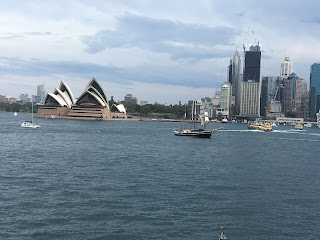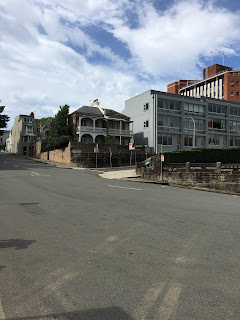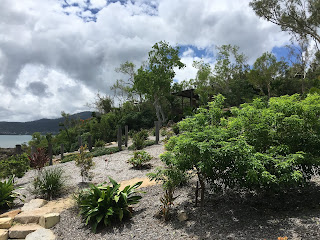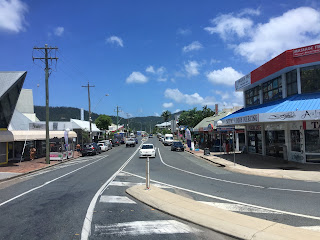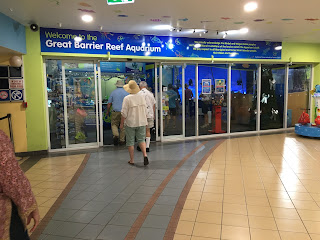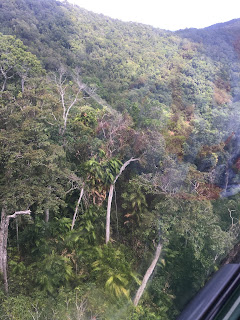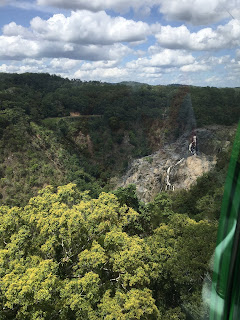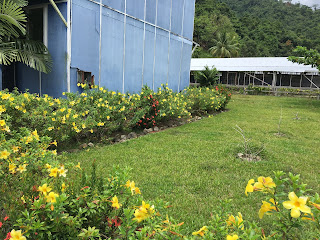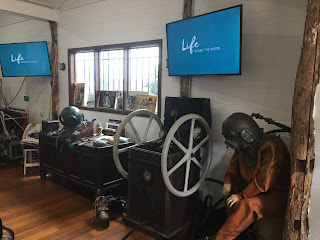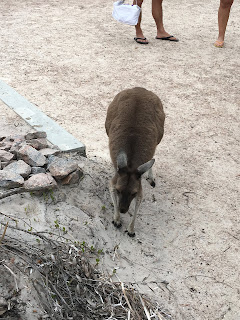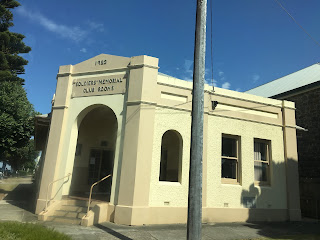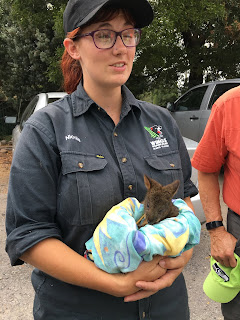GRAND AUSSIE ADVENTURE
10 December 2018 - 20 January 2019
We booked a 36-night-cruise that circumnavigated Australia aboard the Regent Seven Seas Mariner.Regentlater upgraded the cruise to include 3 pre-cruise nights in Sydney at the "Four Seasons Hotel." We booked our own airfare on Qantasroundtrip DFW/SYD. Catherine of American Express Travel managed our bookings. This was our second trip “Down Under.” In 2004, we cruised New Zealand and Australia with a land trip into the interior.
We departed DFW on 10 December; losing a day in flight, we landed in Sydney on 12 December and were driven to the "Four Seasons Hotel."
On Thursday, we had a tour arranged by Regent. It included a harbor cruise with lunch onboard
and an afternoon bus tour that included Manly and the Northern Beaches.
We had a photo stop almost beneath “Sydney Harbor Bridge” for an excellent view of the “Sydney Opera House.”
We spent the remainder of our time in Sydney just doing our own thing.
On Friday night, there was a Cocktail Party and Dinner. They brought in two koalas, a wombat, a joey, a baby crocodile, and a rock python.
We boarded the ship on Saturday 15 December. Imagine having dinner viewing the “Sydney Opera House” through one window and the “Sydney Harbor Bridge” through another.
Moolooaba – Captain announced that the swells were too high to operate the tenders safely, so he was aborting the port.
Coral Sea - During the noon briefing, the Captain announced that a medical evacuation by helicopter would occur within the next hour and a half or so. During the evacuation, all open decks, including balconies, were to be evacuated. Just before 1:30, we heard the helicopter and an announcement was made to please evacuate the decks. The medical evacuation took longer than it does on TV, but the process was completed by 2:00, and the Cruise Director announced that we were free to use the open decks and balconies.
Airlie Beach - The ship was at anchor as this was a tender port; however, a ferry transported us between ship and shore. Airlie Beach is a tourist area and gateway to the “Whitsunday Islands.” It relies heavily on tourism and has two marinas. About 4 years old, it was created on reclaimed land and boasts several thousand beds for holiday travelers. Almost everything is geared to the reef, the beach, or the water. We left the port and drove through the small town, population 11,000. Our first stop was “Northerlies,” a mountain-top bar, where we had pastries and morning tea.
After about 3/4 hour, we headed back down and drove to Proserpine to visit “Proserpine Historic Museum,” filled with items donated by locals detailing the history of the area. The local crafts for sale included dozens of crocheted items, a few machine made quilts, and dozens of fancy aprons.
Along the way, the driver pointed out evidence of damage by Cyclone Debbiewhich happened 2 years ago. She also told about sugar cane production, pointed out the differences in the plants in the fields, the narrow gauge railroad, the carts used to transport the cane, and the mill. From the museum, we drove back to Airlie Beach; we enjoyed seeing the area, but they didn’t have a lot to show.
Townsville - The day was sunny with a few clouds and hot with mid-afternoon temperature about 88 and 59% humidity. After departine the pier, we passed the sugar mill and saw rail cars of raw sugar waiting to be off loaded and graded before being loaded into ships for export. The nearby area contains a zinc mine, a nickel mine, and a copper mine; the copper is exported in sheets to be used in electrolysis. We drove through the city, which has a population of 200,000, seeing various sites; notably a round building locals call “the Sugar Shaker” and “Castle Hill.”
Then we drove along “The Strand” to our first stop, “Reef Headquarters/Reef HQ.” This huge aquarium contains many tanks replicating the ”Great Barrier Reef” and its animals. First we saw the “Turtle Hospital” with three turtles being rehabbed. Then we toured various tanks with a guide; she pointed out the various corals, fish, etc. and briefly talked of each.
After about an hour and a half, we walked a half block to the “Museum of Tropical Queensland.” It contained more coral reef information, rainforest exhibits, as well as an exhibit dealing with the shipwreck of the “Pandora.”
Cairns - [Overnight]
As we had been to the "Great Barrier Reef" on our previous trip, we decided to go inland this time. We got a brief look at Cairns as we drove though on our way to Smithfield. Here, too, we saw sugar cane fields and the narrow gauge rail tracks for transporting the cane between the fields and the mill. Crocodiles abound in the rivers and all the marshy areas; signs are posted warning people not to enter the water. At Smithfield, we boarded Skyrail, a gondola cableway stretching about 4.7 miles long that was completed in 1995. To avoid disturbing the natural environment, all towers supporting the cables were lifted into place using helicopters and no trees were cut. As we slid along, the world’s oldest rainforest spread below us. We changed gondola cars at “Red Peak Station,” the highest point, which has an altitude of 1788 feet. We changed cars again at “Barron Falls Station” but chose not to walk down to the falls. It took an hour or so to make the trip to Kuranda Terminal where the cableway ended.
Although Kuranda is in the mountains at almost 1100 feet, it was still hot with a temperature in the mid-to-upper 80s and about 70% humidity. The shops were filled with tourist items or merchandise sometimes seen at street fairs. The place had sort of a hippie vibe. We boarded a bus for the return to Cairns. The road twisted and turned its way down the mountainside to Cairns. As we drove back through the CBD to the port, we saw fruit bats asleep in the trees lining the street.
Alotau, Papua New Guinea – [Our 120th country] - A relatively new country with ancient origins, PNG gained independence from Australia in the 1970s. During WWII, the island was the scene of intense fighting between the Japanese invaders and the Australian/British/American forces. When the Japanese received their orders to “advance to the rear”—-they had no word for retreat—-the invasion of Australia was thwarted. Rhythmic drumming punctuated with occasional screaming indicated the presence of local dancers on the pier.
It was hot: 91 degrees and 56% humidity. We had been warned that the tour vehicles might not have A/C and that the tour guide’s English might be limited. Luck of the draw: our minibus had A/C and there were only 9 of us aboard, so it wasn’t crowded. Mary, our guide,
spoke excellent English and was the lead guide for the 4 buses in this tour. She wished us “Merry Christmas” and told us that PNG is a Christian country. Mary pointed out sights along the way as we exited the port area and drove through town
on our way to “Hiwehiwe Lookout,” where we got out and made some photos.
While there, Mary gave a brief history of the area and another guide spoke of its WWII history. We made some photos of locals in native dress; one man held a pet possum. Of course, we tipped those whose photos we took.
After reloading the minibuses, we drove down through the center of town
and stopped at “Cameron Secondary School” where George, the head boy, and Faith Hope, the head girl, gave us a tour. The school, named for the Cameron Highlanders Regiment, wasn’t in session as they’re in the third week of their long break and won’t return until the end of January. Enrollment is 800 with 200 students boarding; they grow their own food and cook and serve their own meals. All instruction is in English.
While there, a group performed some traditional folk dances and showed some crafts. We put a donation into the school donation box provided.
Our final stop was the produce market.
Because it was Christmas Eve, the entire town was extremely crowded because everyone was shopping for Christmas.
Many people come to Alotau by boat and “Sanderson Harbour” had lots of small craft waiting for a return trip.
We could tell there are various levels of prosperity within the society; part of it was that those who live in “Top Town,” the area where the Aussies lived, are the most prosperous. Although we were told there wasn’t much crime, all properties were surrounded by fences, and many places had onsite security.
Port Moresby, Papua New Guinea - The Captain announced that we would skip Port Moresby. Because it was Christmas Day, there would be no tour operations in Port Moresby and there would be no pier or pier services available. They claimed to have just received the informatio, but we had wondered all along what would be available on Christmas.
Darwin - Because we had cruised out of Australia, every passenger had to do a face-to-face with Australian Immigration prior to going ashore. The first stop on our tour was ‘Crocodyleus Park” where we spent about 2 hours.
It’s a breeding park where the animals are raised for their meat and their hides. It was 91 degrees with 90% humidity—-HOT! We saw the crocodiles being fed using chicken tied to a rope and pole, not unlike a fishing set up. Their natural behavior is to leap from the water, and we saw it 8 or 10 times with different crocs in different pens.
They also have a zoo-like area with other animals; we saw ostriches; emus; lions. Tate, our park guide, fed the lions. We had been warned that the male might spray urine through the fence; he backed up to the fence, lifted his tail, and sprayed. We were not affected.
We were melting and went inside the air-conditioned museum where we cooled down. We drove from the park to the “Museum and Art Gallery of Northern Australia” where we looked around for about 45 minutes.
After leaving the museum, we received a short tour of downtown Darwin on the way back to the ship.
Komodo Island - We decided not to go ashore on Komodo Island as we were here last year.
Bali - [Overnight] Although this was our third trip to Bali it was our first daylight sail into Benoa, Bali and the scenery was amazing: parasailers; jet skiers; boaters; watercraft of many types. It was one of the most enjoyable scenes of the trip.
At 1:00 we met our tour, Balinese Arts & Crafts. We boarded a bus with Ari as guide. Our stops: a store manufacturing and selling gold/silver jewelry; a workshop making bamboo furniture; a wood carvers studio; an art gallery; a batik store. Of course, we’ve been to these or other places like them previously.
The second day, we disembarked, walked through the terminal, and continued to a small market. As we left the harbor, we saw the local pilot disembark.
At Sea - Another face-to-face with Australian Immigration. We kept the passports and the completed immigration card this time.
Broome - It was sunny and hot—-88 degrees with 60% humidity. We boarded a bus for our tour. It was red dirt and scrub brush as far as the eye could see, and the guide said they raise Brahma cattle here. We didn’t see anything for cattle to eat. We knew they had camels, and that made sense. But cattle?
We began a drive through town but quickly realized the bus’ air conditioner was only blowing warm air. It was decided to go immediately to the “Pearl Luggers Museum” for the hour-long tour; during that time, someone would come and repair the bus. We enjoyed the museum about the pearl industry in Broome. Luggers were the boats, which transported the divers to the oyster beds and on which the divers lived for weeks at a time. We also saw diving equipment and a 1950s era film about the divers. Divers were originally Aboriginals and later Japanese, Malays, and Chinese were lured into the trade; many were forced into diving and all were underpaid.
Afterwards, we went to the shop where we saw items for sale as well as a huge pearl worth $100,000
and an exceptional gold nugget worth more than twice the price of the pearl.
By now, the hour was up and we were told a minimum half hour more to repair the bus. A shuttle bus came, more than half full, and we boarded for the ride back to the ship.
Exmouth - Scratch Exmouth and change that to a sea day. The Captain aborted the port because the swells were too high to operate the tenders safely. He also said he was altering the route to our next port because of rough seas; we would sail closer to shore. We weren’t far off shore but through the haze it looked like a white strip with a grayish line above it. It was impossible to tell anything about the height of the coastline or the vegetation.
Fremantle/Perth – The climate is a Mediterranean one with warm days and cool nights. Today’s temperature was in the upper-70s to low-80s with about 60% humidity; there was a sea breeze in the afternoon.
Our drive took us through portions of Fremantle with Margaret pointing out points of interest. Fremantle was the poorer of the two cities, and therefore the old buildings weren’t razed and replaced. Now the structures are protected; the exteriors must remain the same even if the interior is completely gutted. No structure can be over 3 stories tall. We enjoyed seeing the Victorian and Edwardian architecture, the “Round House” and “Fremantle Prison.” We also drove through several posh suburbs.
After stopping at a “Cottesloe Beach,”
we headed for Perth.
Our first stop there was “Kings Park.” We made some photos of the “War Memorial. “
After about 40 minutes, we drove downhill and through the city; many buildings are modern skyscrapers. They are very proud of their new stadium as a venue for cricket and Australian rules football, and rugby.
After returning to Fremantle on a road along the Swan River, we stopped at “Monument Hill” for photos before returning to the ship.
Esperance - We anchored in the port of Esperance as there is no pier for passenger ships.
Although the day began partly cloudy and chilly enough for jackets, the sun came out and it warmed into the low-to-mid-70s. We tendered ashore in a very full tender—-get as many ashore as quickly as possible. Once ashore we boarded the bus and set off on the tour. There is a commercial pier used for shipping grain, wood chips, lithium, nickel and other products; we were told that millions of dollars of nickel have been shipped from this port for decades. Esperance is noted for its beaches, said to be the best in Australia, and every campground and caravan-park we saw was packed with tents, RVs, and other vehicles. The guide said all were full this time of year and many would have been reserved a year in advance. After driving along the beachfront of the town of 14,500 people, we headed out into the countryside. The guide said about 3000 children attend school in Esperance, many of them riding a school bus as much as an hour-and-a-half each way. We saw quite a lot of trees with orange/yellow flowers. We were told they were “Christmas Trees” and parasitic in that their expansive root system poisons all other trees nearby.
Our first stop was “Stonehenge,” a full scale replica of the famous ruin, which is built of granite. The owner/builder gave us a tour. It might be considered somewhat “hokey,” but seeing a complete structure and hearing about its construction as well as its celestial orientation was interesting. The owner raised crossbred cattle.
From there we drove toward “Cape LeGrand National Park.” Along the way were pastures with cattle; some appeared to be purebred Black Angus; one field held Holsteins; most were just cattle. Several pastures had windmills pumping water into tanks; another had rolls of hay. A few acres of “Blue Gum Trees” grown for export to Japan as wood chips to make paper appeared roadside.
After entering the national park, our first stop was “Hellfire Beach” where we saw pristine while sand and turquoise water. Waves crashed on the beach and several young people enjoyed the surf.
From there we meandered our way past the fresh water lake that first attracted European explorers to this area
and on to “Lucky Beach,” famous for its kangaroos. We did see a few gray ones.
After a photo stop for “Frenchman’s Cap” mountain, it was pedal-to-the-metal back to town.
Kangaroo Island - The ship was at anchor off Penneshaw, Kangaroo Island. We decided to stay aboard and not do today’s tour as we’d been here previously. We must have made the correct call on staying aboard because multiple people talked about how rough the tender ride was. One person said it was his roughest ride in a long time; another said she was surprised they were still operating the tenders because of the waves. I went topside to made a few photos, and the wind was so strong it was difficult to hold the iPhone still enough to make photos.
Adelaide - We docked in Adelaide, the capital of South Australia. We had visited the area’s wine regions when we were here in 2004 and chose something different today. Today’s tour took us through the historic town of Port Adelaide and then through Adelaide itself
before taking us into the hills to the town of Hahndorf. It was founded by German Lutherans in the 19th century and still has somewhat of a German feel, at least in the names of some businesses. We had 2 hours to walk the main street. We left the town at noon and drove to the Mount Lofty Lookout for a view of Adelaide and surroundings spread below.
The day was bright and sunny with a clear, blue, cloudless sky. Temperatures were around 80 and it felt good to be outside and ashore. Some of the concrete dividers on the freeways have mesh over them at intervals so that koalas are able to climb over them as they cross the highway.
We had a driving tour through another part of Adelaide itself and a view of the beach before returning to the ship.
Portland - As we had no tour, we spoke with the local hospitality person on board. He explained about the free shuttle service, the sights to see, gave us a map, and offered us brochures. We were tied up alongside the “Lee Breakwater.”
A minibus shuttle was waiting and we boarded. Portland is the oldest settlement in Victoria and many buildings are listed as “Heritage Structures.” The shuttle made a loop through town passing the main sights: Nun’s Beach; Commercial Port; Court House; Botanical Gardens; Cable Trans Deport; Post Office; Mac’s Hotel. They also pointed out the War Memorial inside a former lighthouse. A traveling carnival was in town and the market had opened because a ship was in port.
In the port, we saw a tractor trailer rig on a ramp which tilts the entire rig 80% to unload it. We learned they only get 2 or 3 cruise ships a year. The entire shuttle loop took about 30 minutes; seeing no place we wanted to return, we embarked the ship when the shuttle returned to the pier. The port ships tons of wood chips which are used to make paper; the light colored ones were pine and the dark ones were Blue Gum.
Melbourne - [Overnight] - This was our second visit to Victoria’s capital city, which Aussies pronounce “Melbun.”
We left the port and drove into the city. Our first stop was “Eureka Skydeck 88” billed as “The Southern Hemisphere’s Highest Viewing Platform.” It’s 975 feet high. A 40 second elevator ride whisked us to the 88th floor of the building. There were 360 degrees of views. We made some photos even though it was a bit hazy.
Leaving there, we drove through the city; along the Yarra River, we saw rowers. The “Exhibition Hall” from the 1888 World Exposition sits adjacent to
“The Melbourne Museum.” Inside the museum, we made a photo of a pygmy blue whale skeleton and of Phar Lap, a famous race horse, stuffed and on display.
We passed “Flinders Street Station,” St. Paul’s Cathedral,” and “Federation Square.” In “Federation Square” we saw a crowd of people seated in chairs and were told they were watching the Australian Open on an outdoor screen.
As we made our way across the city, we saw the ball boys and girls from the Australian Open Tennis Tournament being walked to lunch.
Our last stop gave us a choice of the “Botanical Gardens” or the “Shrine of Remembrance,” a war memorial. We chose to make some photos of the shrine but didn’t climb the steps to the interior.
Our route back to the ship took us near “Albert Park Lake” and the route of the “Melbourne Gran Prix;” there were black swans on the lake. After a drive along the beach, we returned to the ship. As we sailed out to sea the next day and neared the entrance to the harbor, we heard our ship's horn; on our TV, we could see a freighter in our path.
Burnie - We docked in Burnie’s commercial port on Emu Bay. The busy commercial port had ranks of containers, stacks of logs, and mountains of wood chips, and it was closed to the public. We drove out of the port and through the small town of Burnie . Burnie’s claim to fame was the “Associated Pulp and Paper Mill” which closed the 1990s and the economy really took a hit. After driving along the shore and through suburbs for a while, we made our say into agriculture. Literally hundreds of dairy cattle and many herds of beef cattle filled the pastures. We also saw horses, sheep and goats. Farm crops of potatoes, wheat and opium were irrigated, as were several pastures. There were lots of rolls of hay, all wrapped in plastic. In one place, dozens of long greenhouses were used to grow berries. Many houses had small produce stands in their front yards and the profusion of blooming flowers in yards amazed us. We stopped briefly to make a photo of “Gunn’s Plains,” a vast valley. The hilly terrain dotted with farms and animals was almost picture book.
We flew non-stop Sydney to DFW on 20 January.



















